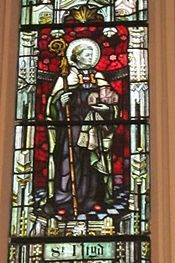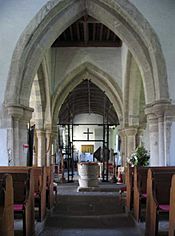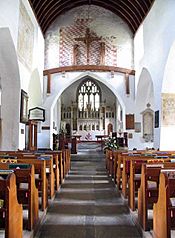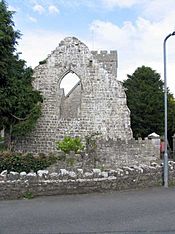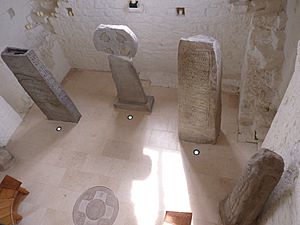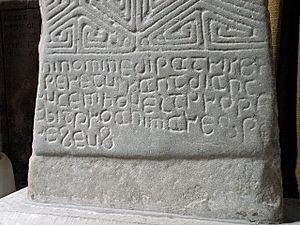St Illtyd's Church, Llantwit Major facts for kids
St Illtyd's Church is a very old church in Llantwit Major, Vale of Glamorgan, Wales. It stands where the oldest college in the United Kingdom once was. This college, called Cor Tewdws, started around 395 AD. It was named after a Roman Emperor, Theodosius I. Later, around 508 AD, St. Illtud restarted the college, and that's how the church got its name.
The church building you see today was mostly built by the Normans in the 11th century. Parts of it were updated in the 13th and 15th centuries. It's one of the oldest and most famous parish churches in Wales. It's so special that it's called a "grade I listed building," meaning it's super important. Some people even call it the "Westminster Abbey of Wales" because of its amazing carved stones and statues. Others say it's "the most beautiful church in Wales."
Today, the church is part of the Llantwit Major area in the Diocese of Llandaff.
History
The First College of Theodosius
Around 380 AD, the Roman Emperor Theodosius I made Christianity the official religion of the Roman Empire. This meant that older, many-god religions were no longer supported. A college was built here to honor him around 395 AD. Some stories say Theodosius himself founded it, but there's no real proof he was ever here.
This college was the very first school in Great Britain. Some even call it the "oldest college in the world." It was founded near the end of the Roman time in Britain. After the Roman soldiers left around 409-410 AD, Britain was attacked by groups like the Irish and Picts. They burned villages and churches, taking people as slaves. The College of Theodosius was supposedly burned down by Irish pirates in 446 AD and left empty.
There's a story that St. Patrick was kidnapped from this college when it was attacked. However, this story probably isn't true. St. Patrick himself said he was only 16 when he was taken, which would be too young to be in charge of a college.
St. Illtud's School, Bangor Tewdws
The college site was empty for 62 years. Then, around 508 AD, St. Illtud reopened it. According to an old book called the Book of Llandaff, St. Dubricius asked Illtud to restart the college. The place then became known as Llanilltud Fawr, which means "Illtud's Great Church" in Welsh. The school also had other names like Bangor Tewdws (College of Theodosius) or Bangor Illtyd (Illtyd's college).
This college was likely built from wood or mud and straw. It became very successful, and many famous Celtic saints are said to have studied there. These include Saint David, Saint Samson, Saint Paul Aurelian, and Gildas the Historian. Some stories claim the college had seven halls and over 2000 students. However, these numbers come from a manuscript that might have been made up by someone named Iolo Morganwg. The ruins of the old school are thought to be in a garden north of the churchyard.
The Norman Invasion
The college was probably attacked by the Danes in 987. But it was the Normans who changed it the most. In the 11th century, a Norman noble named Robert Fitzhamon conquered the area of Glamorgan. He likely attacked by sea around 1080.
During this conquest, the wooden college and church were destroyed. Its money and lands were given to a new church called Tewkesbury Abbey, which was Fitzhamon's own project. For a while, the church even lost its right to be a safe place for people seeking protection. This right was only given back in 1150. The Normans eventually rebuilt a new church on the old college's ruins around 1100. But the college became much smaller and less important.
13th Century Rebuilding
In the 13th century, the church got a big makeover. A low tower was added to the east end. A second chapel was built next to the first one, sharing a wall in the middle. The old western chapel was still used by the local people. But the new eastern chapel was for the monks. Later in the century, a large farm (called a grange) was set up west of the church.
15th Century Rebuilding
Around 1400, the East monastic church was made bigger with side aisles. Its roof and tower were also raised to their current height. The church got a new roof made of strong Irish oak. It was also decorated with many murals (wall paintings) and carvings. A special chapel, now called the Galilee chapel, was also added to the West chapel by Sir Hugh Raglan.
After the Monasteries Closed
In the 16th century, during a time called the dissolution of the monasteries, the group of monks living here was disbanded. The East chapel then became the main church for the local people. During this time, and later during the Puritan period, the medieval farm declined. The inside of the church fell apart, and many murals and statues were ruined. The West chapel was not used much and became a storage place for old church items. It wasn't fixed up and used regularly again until the early 1900s.
Church Architecture
The church is long and made up of different buildings. It's split into two main parts by a wall: the East chapel, which was a monastery church from the 13th century, and the West chapel, which was a Norman church for the local people. The church grounds also have a 13th-century gatehouse, a pigeon-house for monks, and old ruined walls in a garden.
The West Chapel
The West chapel is about 40.5 feet long. It was built in the Romanesque style, which was popular with the Normans in the 12th century. It was a simple cross-shaped church. There's good evidence it was built on top of an even older church, possibly from St. Illtud's time. This part of the church was meant for the local community. It's the oldest part of St. Illtyd's Church that is still standing. It was very neglected after the monasteries closed but was restored in the early 1900s.
Inside, you can find a curfew bell and medieval statues of priests. There's also an old carving for King Rhys ap Arthfael of Morgannwg, who died in the mid-9th century. The West chapel is still used for church services and holds many historical items.
The East Chapel
The East church has interesting features like "squints" (small holes to see the altar), stone benches, and a carved stone screen behind the altar. You can also see marks on the tower that show how the church changed over time. Other cool things in the East chapel are the medieval wall paintings. These include the Royal Standard of King James from around 1604, a painting of St. Christopher from about 1400, and paintings of Mary Magdalene and the Virgin Mary on the walls of the Chancel.
The Galilee Chapel
The Galilee chapel was built at the western end of the West chapel in the 13th century. It was near the sacristy, where church clothes and special plates were kept. We don't know its first use, but Sir Hugh Raglan gave money for it to be a special prayer chapel around 1470-80.
When the government stopped these special chapels during the time of Edward VI, the Galilee chapel became a ruin for many centuries. In 2013, after two years of raising money, the "Galilee Project" successfully rebuilt it. It's now a visitor center and a place to show off the ancient Celtic crosses. The chapel was officially reopened in November 2013.
Galilee Chapel Renovation
Project History
After the special chapels were closed during the Reformation, the Galilee chapel fell apart. It was a ruin for almost 400 years. In 1963, the church leader started thinking about fixing it up. In 2006, a group was formed to rebuild the chapel. They wanted it to be a place to show the Celtic stones and tell the story of Christianity at the site.
In March 2009, they received a grant of £37,500 to draw up plans for the renovation. The "Galilee Project" website started in September, sharing information about the chapel's history and plans. The project was also shown to the local community in November 2009. In December 2010, the project received a much larger grant of nearly £300,000 to renovate the chapel.
Throughout 2011, the project focused on raising more money and held talks about the site's history. By April 2012, they had enough money to start building. Work began in September. During the renovations, archaeologists found 8 complete skeletons in and around the chapel in November. As the chapel was being fixed, the Celtic stones were cleaned and prepared for their new home. In October, they were moved from the West Chapel to the new Galilee exhibition space.
After 400 years of being a ruin, the restored chapel opened on November 2, 2013. Many visitors came to see the doors open to the Galilee Chapel. The opening ceremony included a speech and prayer. The ribbon was cut by Llantwit's oldest resident, Gladys Kilby (94), with the youngest member, baby Violet, just one day old! An art and music festival was also held. The next day, the chapel was rededicated in a service led by important church leaders, including Dr. Barry Morgan, the Archbishop of Wales.
The whole project cost almost £850,000. Money came from the Heritage Lottery Fund, the local council, church fundraising, and many private donors.
Renovations
Because the chapel was a ruin for so long, the architects wanted to keep some of that "ruined" feel in the new building. They kept all the old walls and details. New parts were built so they touched the old structure "very lightly." Also, all new work could be taken apart without damaging the old parts. The redesign also made the chapel easy for wheelchairs to access, with a ramp and a special toilet.
The new roof is held up by a central wooden frame. A second floor, called a mezzanine, was built for offices. This mezzanine doesn't fill the whole space. It stops short of the west end, leaving a high display area for the Celtic stones. On the ground floor, a space was made to show the Celtic stones, and modern bathrooms were put in. The old sacristy building now has a tea-making station. The upper floor of the sacristy is used for archives and research.
The display area for the stones uses simple, striking materials. The floor is shiny limestone, and the walls are plain white. This simple background makes the rugged grey Celtic stones stand out.
Local builders and artists worked on the renovation. Corinthian Stone Masonry worked on the old stone walls. Veon Glass designed and made the many glass windows and doors, including special windows fitted into the crumbling walls.
The Celtic Stones
One main goal of the renovation was to create a new home for the church's ancient Celtic stones. These stones are from the 9th and 10th centuries. Before, they were kept in the West church, some in the churchyard, and some even in private gardens. They were brought into the church for protection during renovations in the late 1800s.
The Houelt Cross is a beautiful example of a Celtic wheel cross. It has lovely carved patterns. It remembers the father of Houelt ap Rhys (Hywel ap Rhys), who ruled the area of Glywysing (Glamorgan) in the 9th century. One translation of its Latin message says: "In the Name of God the Father and of the Son and of the Holy Spirit. This cross Houelt prepared for the soul of Res his father."
The Sampson Cross is about 2.15 meters (7 feet) tall. It probably once had a wheel cross on top, but that part is now missing. It has carvings on its west and east sides. The west side says: "Samson placed his cross for his soul." The east side says: "(For the soul of) Illtud, Samson the King, Samuel Ebisar." This cross used to be in the churchyard. When it was moved inside, two skeletons were found underneath it.
The Sampson Pillar, also called the "King's Stone," is 2.75 meters (9 feet) tall. It's very worn, but it once had a message with the names of Samson the Abbot, Artmail (another abbot), and Ithel, a 9th-century king. Its message says: "In the name of the most high God begins the cross of the Saviour which Samson the Abbot prepared for his soul, and for the soul of Iuthahelo the King and of Artmail and of Tecan." Iuthahelo is thought to be King Ithel, who died in 846.
This stone has a fun old story. While it was in the churchyard, a "giant's grave" was dug next to it. The "giant" was a 7-foot, 7-inch young man named "Will the Giant." The stone fell into the grave, almost hurting some people. Since it was too heavy to move, it was buried with the giant! The stone was found again by Iolo Morganwg in 1789 and dug out of the grave.
The stones were cleaned by a stone expert named Corinne Evans. She used steam and special pastes to remove over 1000 years of dirt and marks. Some parts even had tiny paint splashes that needed careful removal with a scalpel.
Phase II
As the Galilee Project finished, and the Celtic stones moved to their new home, a "Phase II" project was planned. This project aims to improve the West chapel, which is now empty. Plans include new flooring, heating, lighting, and storage. These updates would make the West chapel more useful for the Llantwit Major community. It could become a space for meetings, workshops, performances, and exhibitions.
Images for kids



